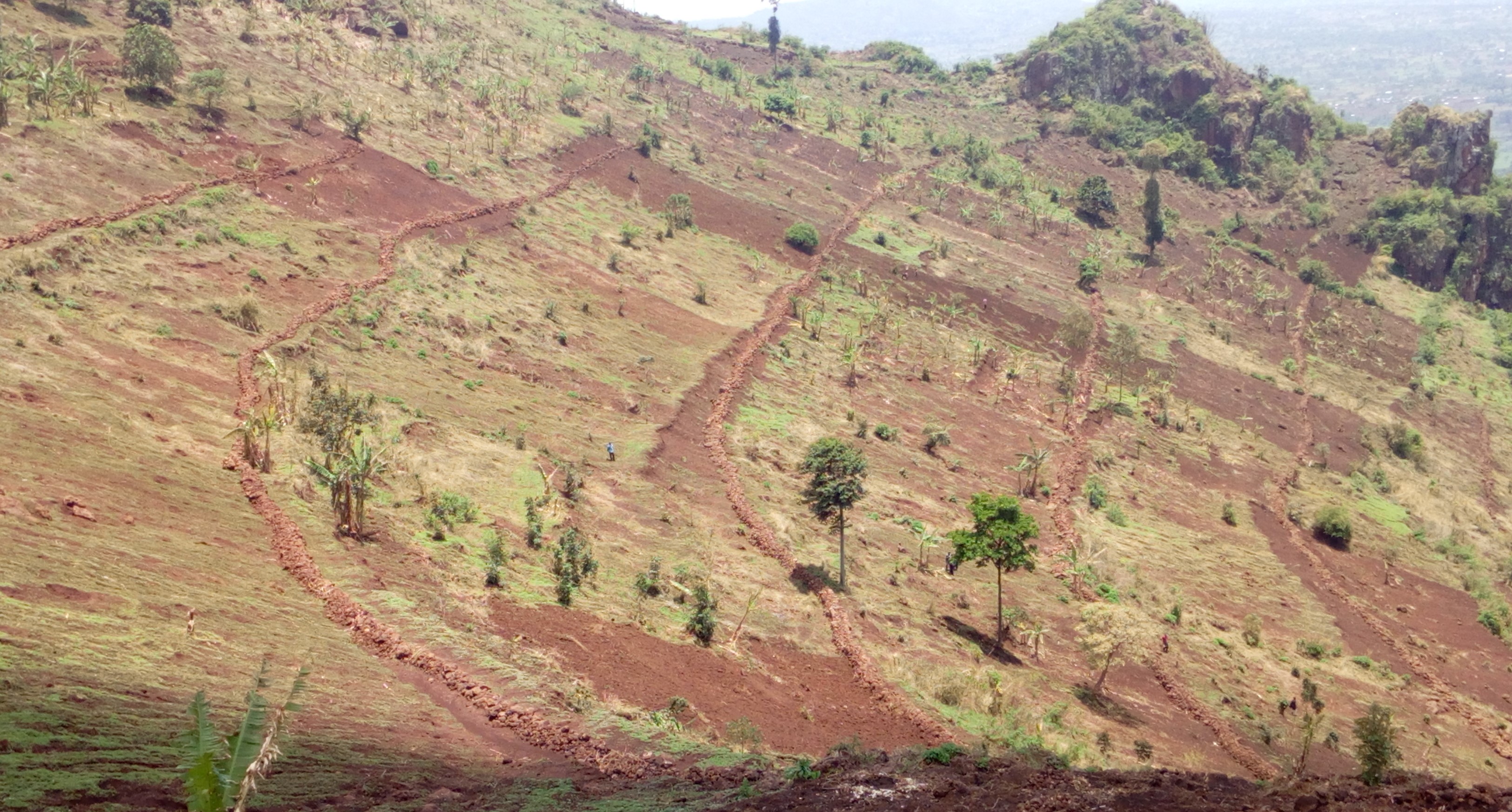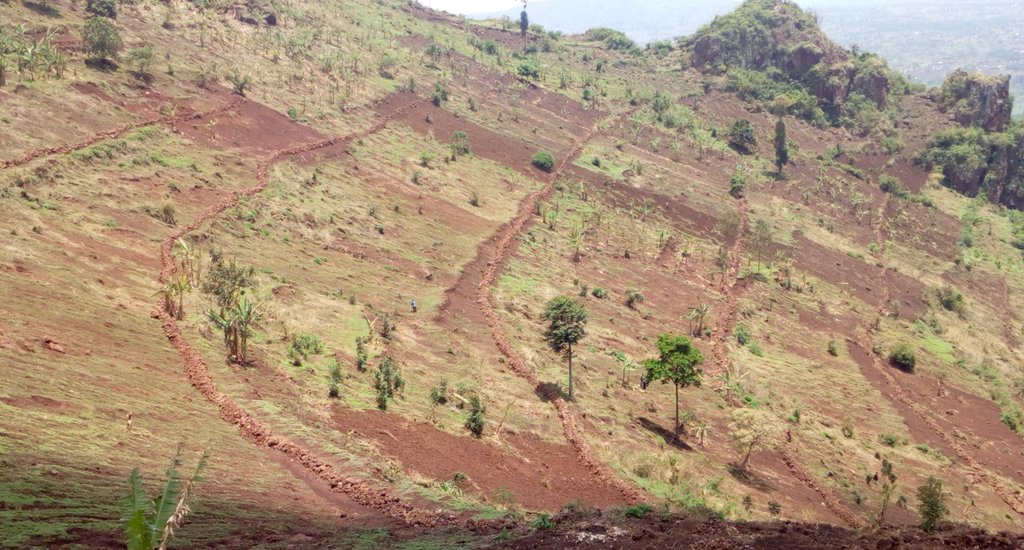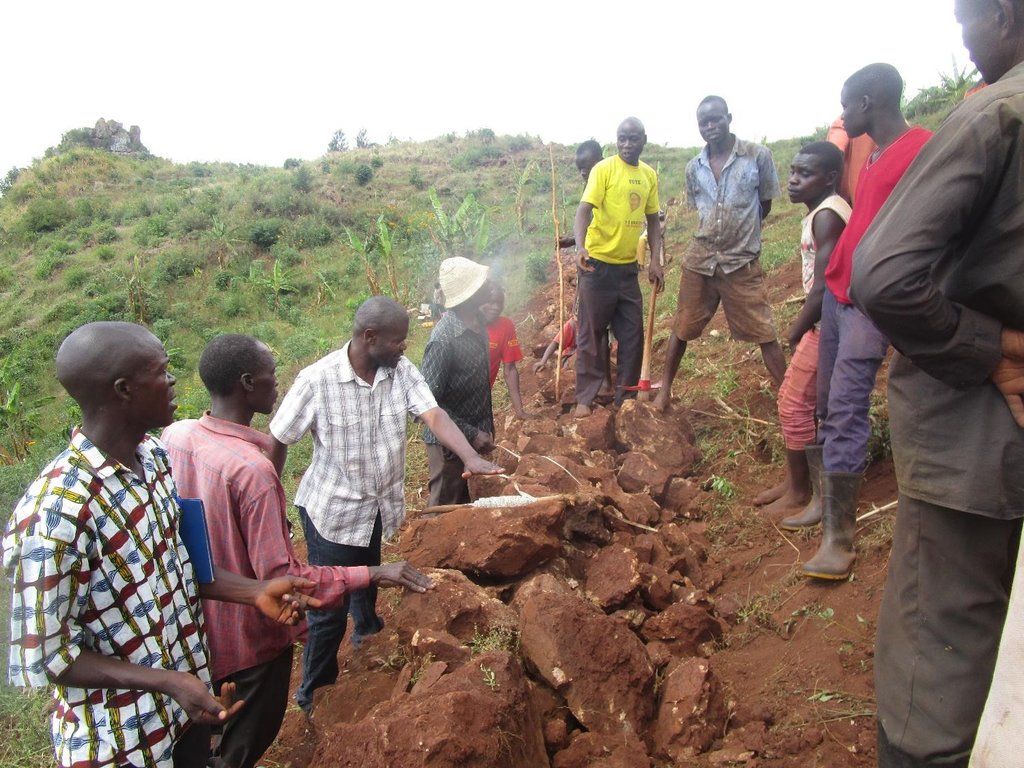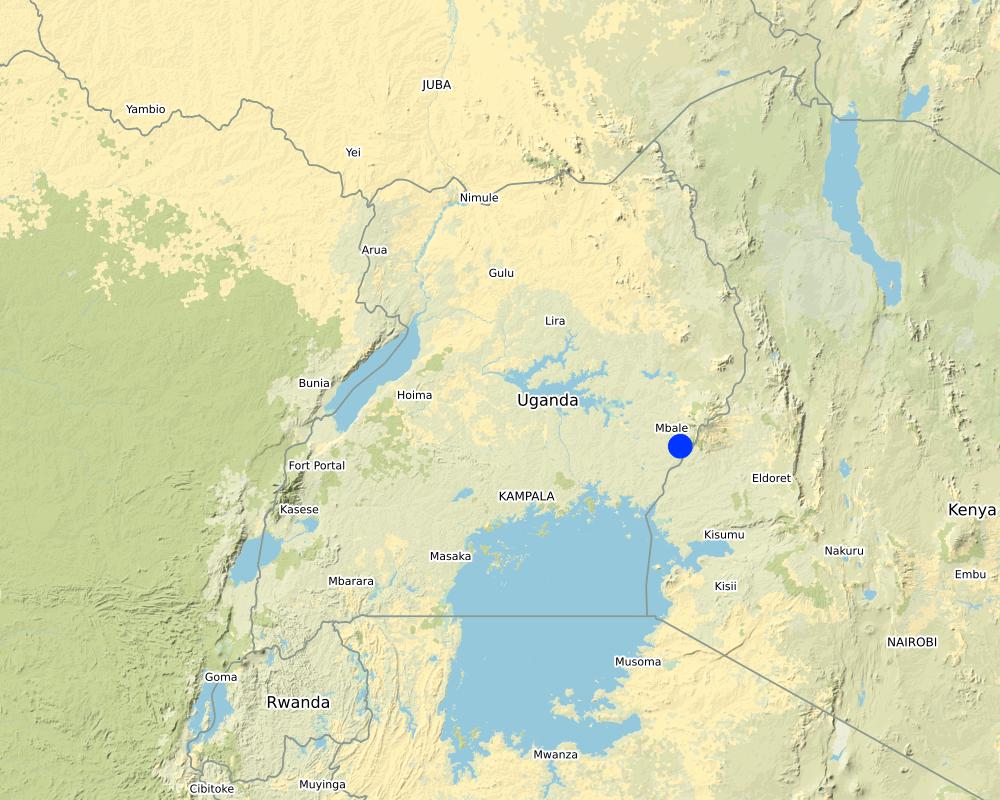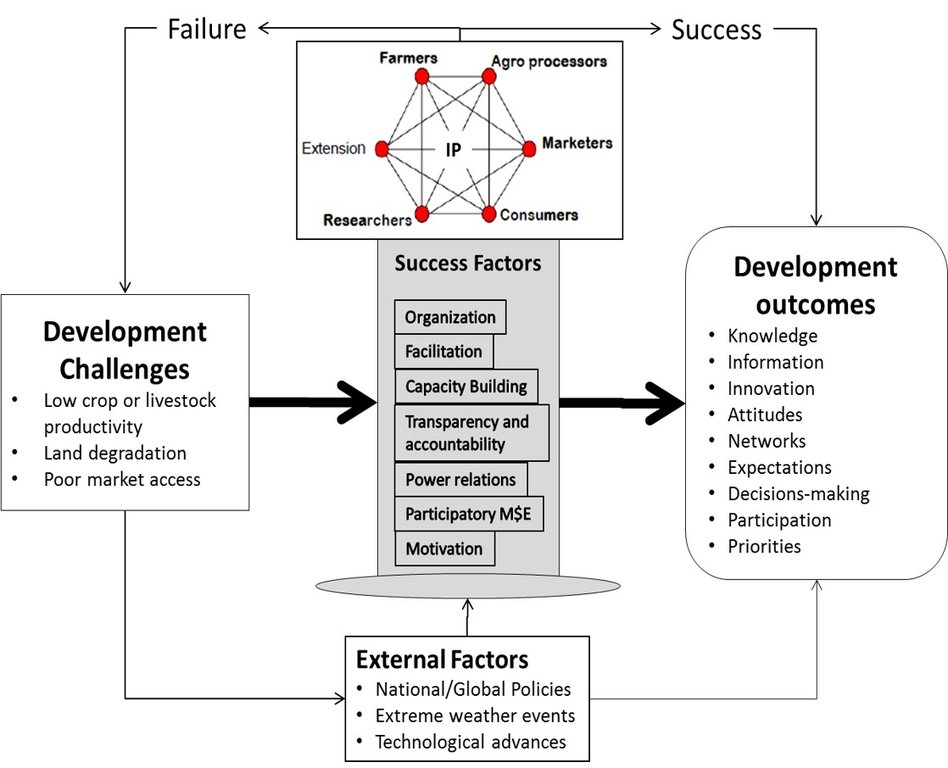Innovation Platform Approach (IPA) for Collective Action in SLM [អ៊ូហ្គង់ដា]
- ការបង្កើត៖
- បច្ចុប្បន្នភាព
- អ្នកចងក្រង៖ Bernard Fungo
- អ្នកកែសម្រួល៖ Dr. Patrick Musinguzi, Moses Makooma Tenywa, Kamugisha Rick Nelson
- អ្នកត្រួតពិនិត្យច្រើនទៀត៖ Nicole Harari, Udo Höggel
Tubaana Group
approaches_4041 - អ៊ូហ្គង់ដា
ពិនិត្យមើលគ្រប់ផ្នែក
ពង្រីកមើលទាំងអស់ បង្រួមទាំងអស់1. ព័ត៌មានទូទៅ
1.2 ព័ត៌មានលម្អិតពីបុគ្គលសំខាន់ៗ និងស្ថាប័នដែលចូលរួមក្នុងការវាយតម្លៃ និងចងក្រងឯកសារនៃវិធីសាស្ត្រផ្សព្វផ្សាយ
ឈ្មោះគម្រោងដែលបានចងក្រងឯកសារ/ វាយតម្លៃលើវិធីសាស្ត្រផ្សព្វផ្សាយ (បើទាក់ទង)
Scaling-up SLM practices by smallholder farmers (IFAD)ឈ្មោះអង្គភាពមួយ (ច្រើន) ដែលបានចងក្រងឯកសារ/ វាយតម្លៃលើវិធីសាស្ត្រផ្សព្វផ្សាយ (បើទាក់ទង)
Uganda Landcare Network (ULN) - អ៊ូហ្គង់ដា1.3 លក្ខខណ្ឌទាក់ទងទៅនឹងការប្រើប្រាស់ទិន្នន័យដែលបានចងក្រងតាមរយៈវ៉ូខេត
តើពេលណាដែលទិន្នន័យបានចងក្រង (នៅទីវាល)?
12/09/2016
អ្នកចងក្រង និង(បុគ្គលសំខាន់ៗ)យល់ព្រមទទួលយកនូវលក្ខខណ្ឌនានាទាក់ទងទៅនឹងការប្រើប្រាស់ទិន្នន័យដែលបានចងក្រងតាមរយៈ វ៉ូខេត:
បាទ/ចា៎
2. ការពណ៌នាអំពីវិធីសាស្ត្រផ្សព្វផ្សាយ SLM
2.1 ពណ៌នាសង្ខេបខ្លីពីវិធីសាស្ត្រផ្សព្វផ្សាយ
Critical actors in a certain area come together, articulate the perceived challenge, identify solutions, allocate responsibilities and work together towards overcoming the challenge
2.2 ពណ៌នាលម្អិតពិវិធីសាស្ត្រផ្សព្វផ្សាយ
ពណ៌នាលម្អិតពិវិធីសាស្ត្រផ្សព្វផ្សាយ:
Efficient use of natural resources is a critical pathway to achieving green growth. Mountain ecosystems are an example of natural resources that need to be sustainably managed to continue providing economic, social and environmental benefits to the large number of dependent communities. The challenge is that these ecosystems are fragile and highly susceptible to natural disasters and their management requires multi-sectoral, transboundary, interdisciplinary and landscape level interventions. Although several technologies to address land degradation exist, adoption remains low. This has been attributed mainly to a dysfunctional extension system and weak implementation of land management policies/regulations. Working at landscape-scale and ensuring inter-sectoral coordination and cooperation is crucial for effective land management responses.
An Innovation Platform (IP) approach is a mechanism to enhance communication and innovation capacity among mutually dependent actors, by improving interactions, coordination, and coherence among all actors to facilitate learning and contribute to production and use of knowledge. The IP approach is a coalition, collaboration, partnership and alliance of agricultural research and development (ARD) actors. That is, public and private scientists, extension workers, representatives of farmers, farmers’ associations, private firms and non-governmental organizations and government policy makers.
Documentation of this approached is based on experience from a study conducted in the eastern highlands of Uganda. The aim of this study was to improve the understanding of how IPs can enhance adoption of soil and water conservation technologies in the fragile highland ecosystems of eastern Uganda. Control of soil erosion was identified as a challenge to be addressed by the IP. The process involved the key principles as follows:
1. Establishment of an effective leadership – An IP committee was established and trained on critical skills required in group dynamics
2. Facilitating formation of lower-level groups (IP clusters) – this is not a necessary step but was important to implement soil erosion control in Bugobero micro-catchments
3. Capacity building – mainly on soil erosion control using contour bunds stabilized with multipurpose trees (Calliandra and Grevillea). This was done through the Farmer Field School (FFS) approach. Farmers were able to collectively establish 4,000 meters of contour bunds and reduce run-off and erosion significantly
4. Participatory Monitoring and Evaluation
5. Development and implementation of an effective communication strategy among stakeholder; and
6. Facilitating the formulation of by-laws to foster implementation of soil erosion control. A by-law on maintenance of the established contour bunds was initiated and the process is still on-going.
From this experience, the IP intends to implement the FFS approach on other technologies such as fodder-bank establishment from Calliandra along contours bunds, manure management for production and collective marketing of bananas. These interrelated technologies are contributing towards improving the banana value chain, which plays a significant role in the food and income security of a majority of households in eastern Uganda. Data collection on information flow and knowledge sharing among stakeholders is on-going to provides empirical evidence about the potential of this approach. The benefits demonstrated by the IP are a motivation for stakeholders to participate in collective action. The cycle of benefits can lead to a self-sustaining community.
The need to establish an IP can originate from various actors including researchers, farmers, development agencies, NGOs, private companies, entrepreneurs and agricultural artisans, among others. Once a common challenge has been identified, the vision bearer can begin to mobilize other actors and share visions.
The advantages of this approach include:
1. direct and continuous interaction, communication and knowledge sharing among the IP actors
2. quick and continuous feedback from end users (farmers) at all stages of research for development and;
3. timely integration of new knowledge into the innovation process using experiential learning, monitoring and evaluation and the continous feedback
One limitation of this approach is that it requires continuous motivation of the various actors to maintain their interest the IP. Often times the benefits of Natural Ressources Management, NRM are long-lived while most actors look for shorter term benefits, making it difficult to maintain motivation. Conflict is a common occurrence in such multi-stakeholder platforms and only transparent and accountable leadership can overcome this. Examples of situation where conflict situations arise include technology selection, labour distribution, financial and gender biases.
2.3 រូបភាពនៃវិធីសាស្ត្រផ្សព្វផ្សាយ
2.5 ប្រទេស/តំបន់/ទីតាំងកន្លែង ដែលវិធីសាស្ត្រផ្សព្វផ្សាយត្រូវបានអនុវត្តន៍
ប្រទេស:
អ៊ូហ្គង់ដា
តំបន់/រដ្ឋ/ខេត្ត:
Manafwa District, Mount Elgon Region
បញ្ជាក់បន្ថែមពីលក្ខណៈនៃទីតាំង:
Khabungu Parish, Bugobero Sub county
មតិយោបល់:
The site is located on the southern slopes of Mt Elgon
Map
×2.6 កាលបរិច្ឆេទនៃការចាប់ផ្តើម និងបញ្ចប់នៃវិធីសាស្រ្តផ្សព្វផ្សាយនេះ
សូមបញ្ជាក់ឆ្នាំដែលបានបង្កើតឡើង:
2016
2.7 ប្រភេទនៃវិធីសាស្ត្រផ្សព្វផ្សាយ
- ផ្អែកលើគម្រោង/កម្មវិធី
2.8 គោលបំណង/ទិសដៅសំខាន់នៃវិធីសាស្ត្រផ្សព្វផ្សាយ
Improve knowledge-sharing and dialogue among relevant actors in addressing a multi-stakeholder natural resource management challenge
2.9 លក្ខខណ្ឌអនុញ្ញាត ឬរារាំងការអនុវត្តន៍បច្ចេកទេសដែលស្ថិតនៅក្រោមវិធីសាស្រ្តផ្សព្វផ្សាយ
សង្គម/វប្បធម៌/ និងតម្លៃនៃសាសនា
- អំណោយផល
Social capital in form of community cohesiveness encourages people to support the less-privileged such as the elderly, who cannot afford labour to construct contour bunds on their own
ភាពអាចរកបាននៃធនធានហិរញ្ញវត្ថុ និងសេវាកម្ម
- អំណោយផល
Several microfinance institutions have be created with support from government of Uganda to farmer groups, although their priority is not much into natural resource management
- រារាំង
Stringent rules on payback periods and collateral make it difficult for most farmer groups on SLM to access
បរិបទនៃស្ថាប័ន
- អំណោយផល
Existence of several farmer groups can support knowledge sharing
- រារាំង
Enforcement of land management laws inadequate
ការសហការ/ការសម្របសម្រួលតួអង្គពាក់ព័ន្ធ
- អំណោយផល
Decentralization policy in the country
គោលនយោបាយ
- អំណោយផល
Decentralization policy in Uganda allows for establishment of local rules of engagement between farmers and local government
ចំណេះដឹងស្តីពី SLM និងការទទួលបានការគាំទ្រផ្នែកបច្ចេកទេស
- អំណោយផល
Several NGOs and projects are promoting land management practices due to frequent occurrence of landslides in the area
- រារាំង
The largely demand-driven farmer-paid extension system in Uganda does not allow for farmers to seek technical support on land management practices
ទីផ្សារ (ទិញធាតុចូល លក់ផលិតផល) និងតម្លៃ
- អំណោយផល
Increasing population in has driven up the demand for food and agricultural supplies and this creates new markets for farmers' produce
- រារាំង
The difficult terrain makes access to markets terribly difficult for farmers
ទំហំការងារ ភាពអាចរកបាននៃកម្លាំងពលកម្ម
- រារាំង
Shortage of labor due to youth migration to urban areas yet land management technologies are labor intensive
3. ការចូលរួម និងតួនាទីរបស់ភាគីពាក់ព័ន្ធ
3.1 អ្នកពាក់ព័ន្ធដែលបានចូលរួមក្នុងវិធីសាស្ត្រផ្សព្វផ្សាយ និងតួនាទីរបស់ពួកគេ
- អ្នកប្រើប្រាស់ដីក្នុងតំបន់/សហគមន៍
Farmers
Implement land management practices on their farms
- អ្នកឯកទេសគ្រប់គ្រងដីប្រកបដោយចីរភាព/ទីប្រឹក្សាបច្ចេកទេសកសិកម្ម
Agricultural Extension staff
Provide technical advise to farmers
- អ្នកស្រាវជ្រាវ
National Agricultural Research Organization (NARO)
Study the technological, institutional and market approaches and processes for improving the functioning of the IP approach
- អង្គការក្រៅរដ្ឋាភិបាល
Mbale Coalition Against Poverty (Mbale-CAP)
Provision of farm inputs such as tree seedlings of appropriate species
- វិស័យឯកជន
Input dealers, product dealers and banks
Provision of input such as seedlings to farmers and buying of produce such as bananas from farmers. Banks provide low-interest loans to farmers.
- រដ្ឋាភិបាលថ្នាក់មូលដ្ឋាន
Sub county local government
Support the process of preparation and enactment of by-laws of land management
- អង្គការអន្តរជាតិ
International Research Centers (e.g. World Agroforetry Center)
Support research by providing extra expertise to national research centers and sometime laboratory facilities where needed
ប្រសិនមានភាគីពាក់ព័ន្ធច្រើនចូលរួមសូមចង្អុលបង្ហាញភ្នាក់ងារដែលនាំមុខគេ:
National Forestry Resources Research Institute (NaFORRI), National Agricultural Research Organization (NARO)
3.2 ការចូលរួមរបស់អ្នកប្រើប្រាស់ដីក្នុងតំបន់/ សហគមន៍ក្នុងតំបន់ក្នុងដំណាក់កាលផ្សេងគ្នានៃវិធីសាស្រ្តផ្សព្វផ្សាយ
| ការចូលរួមរបស់អ្នកប្រើប្រាស់ដីក្នុងតំបន់/សហគមន៍ក្នុងតំបន់ | សូមបញ្ជាក់នរណាត្រូវបានចូលរួម ព្រមទាំងពណ៌នាសកម្មភាពទាំងនោះ | |
|---|---|---|
| ការចាប់ផ្តើម/ការលើកទឹកចិត្ត | ការគាំទ្រពីខាងក្រៅ | Some groups had already initiated some actions but were not very progressive. A research team came from the the National Research Institute to stimulate the organization of the group on soil erosion control. |
| ការរៀបចំផែនការ | អន្តរកម្ម | Farmers participated in the elections to establish the steering committee of the IP. They also participated in the visioning and articulation of the soil erosion challenge and the means to address it. Farmers also participated in the selection of technological options for soil erosion control. |
| ការអនុវត្តន៍ | អន្តរកម្ម | Local leaders (Local Councils) participated in the formation of lower level IP clusters in each sub catchment and mobilizing households to participate in joint activities on designated days. Farmers participated in the collective action to establish soil erosion control structures across the landscape. |
| ការត្រួតពិនិត្យ និងវាយតម្លៃ | អន្តរកម្ម | Farmers and local leaders were part of the monitoring and evaluation committee of the IP and participated in periodic activities to asses progress towards the set targets such as the extent and quality of contour bunds completed, the rate of soil erosion and the performance of the crops after the bunds are created. |
3.3 គំនូសបំព្រួញ (ប្រសិនបើមាន)
ការពណ៌នា:
Flow Chart of the process that the IP approach needs to go through to be effective
អ្នកនិពន្ធ:
Bernard Fungo
3.4 ការសម្រេចចិត្តលើការជ្រើសរើសបច្ចេកទេស SLM
សូមបញ្ជាក់តើអ្នកណាជាអ្នកបានសម្រេចចិត្តក្នុងការជ្រើសរើសបច្ចេកទេសដើម្បីយកមកអនុវត្តន៍:
- គ្រប់ភាគីពាក់ព័ន្ធទាំងអស់ដែលជាផ្នែកនៃវិធីសាស្រ្តផ្សព្វផ្សាយដោយមានការចូលរួម
ចូរពន្យល់:
Several meetings are held in which all actors deliberate the technological options available and a voting stage decides which of the options is to be selected for implementation. There are also situations when more than one option is considered if they do not contradict.
សូមបញ្ជាក់ តើការសម្រេចធ្វើឡើងដោយផ្អែកលើអ្វីជាមូលដ្ឋាន:
- វាយតម្លៃទៅលើចំណេះដឹងស្តីអំពី SLM ដែលបានចងក្រងជាឯកសារបានត្រឹមត្រូវ (ផ្អែកលើភស្តុតាងជាមូលដ្ឋានដើម្បីសម្រេចចិត្ត)
- បទពិសោធន៍ និងគំនិតផ្ទាល់ខ្លួន(ពុំមានចងក្រងជាឯកសារ)
4. ជំនួយបច្ចេកទេស ការកសាងសមត្ថភាព និងការគ្រប់គ្រងចំណេះដឹង
4.1 ការកសាងសមត្ថភាព/ បណ្តុះបណ្តាល
តើវគ្គបណ្តុះបណ្តាលបានផ្តល់ឱ្យអ្នកប្រើប្រាស់ដី/អ្នកពាក់ព័ន្ធផ្សេងៗទៀតដែរឬទេ?
បាទ/ចា៎
សូមបញ្ជាក់តើអ្នកណាត្រូវបានបណ្តុះបណ្តាល:
- អ្នកប្រើប្រាស់ដី
ទម្រង់នៃការបណ្តុះបណ្តាល:
- ទីតាំងបង្ហាញ
ប្រធានបទបណ្តុះបណ្តាល:
Soil erosion control using contour bunds, types of bunds, size and spacing between them
4.2 សេវាផ្តល់ប្រឹក្សាយោបល់
តើអ្នកប្រើប្រាស់ដីបានទទួលនូវសេវាផ្តល់ប្រឹក្សាដែរ ឬទេ?
បាទ/ចា៎
សូមបញ្ជាក់ប្រសិនបើសេវាកម្មប្រឹក្សាយោបល់ត្រូវបានផ្តល់ឱ្យ:
- នៅលើដីរបស់អ្នកប្រើប្រាស់ដី
- នៅមជ្ឈមណ្ឌលជាអចិន្ត្រៃ
ពណ៌នា/ពន្យល់:
Where the demonstration lots are established, technical staff visit the site and provide support on-site. The zonal research center is also available for interested farmers to visit and learn more about the technological options suitable for the area.
4.3 ការពង្រឹងសមត្ថភាពស្ថាប័ន (ការអភិរឌ្ឍន៍អង្គភាព)
តើស្ថាប័នទាំងអស់ត្រូវបានបង្កើតឡើង ឬពង្រឹងសមត្ថភាពតាមរយៈវិធីសាស្ត្រផ្សព្វផ្សាយដែរ ឬទេ?
- បាទ/ច៎ា ជាមធ្យម
សូមបញ្ជាក់ថាតើស្ថាប័នត្រូវបានពង្រឹង ឬបង្កើតឡើងនៅត្រឹមកម្រិតណា(ច្រើន)?
- ថ្នាក់មូលដ្ឋាន
- កម្រិតថ្នាក់ជាតិ
ចូពណ៌នាពីស្ថាប័ន តួនាទី និងទំនួលខុសត្រូវ សមាជិក ។ល។:
National Agricultural Advisory Services (NAADS) operates at district level through formation and training of farmers groups. Mainstream extension workers at the sub-counties provide training to farmers and farmers groups that are not part of the NAADS groups. The training was augmented by NARO and other NGOs.
សូមបញ្ជាក់ប្រភេទនៃការគាំទ្រ:
- ការកសាងសមត្ថភាព/ បណ្តុះបណ្តាល
- សម្ភារៈ
សូមផ្តល់ព័ត៌មានបន្ថែមទៀតឱ្យបានលម្អិត:
The IP actors, including local government staff, farmer groups and extension staff were trained on various aspects of group dynamics in order to improve their management skills. The sub-county local government was provided with tools (pangas, mattocks and hoes) for use in establishing stone lines.
4.4 ការត្រួតពិនិត្យ និងវាយតម្លៃ
តើការត្រួតពិនិត្យ និងវាយតម្លៃគឺជាផ្នែកមួយនៃវិធីសាស្ត្រដែរឬទេ?
បាទ/ចា៎
ប្រសិន បាទ/ច៎ា តើឯកសារនេះបានបង្កើតឡើងក្នុងគោលបំណងប្រើប្រាស់សម្រាប់ការត្រួតពិនិត្យ និងវាយតម្លៃដែរឬទេ?
ទេ
4.5 ការស្រាវជ្រាវ
តើការស្រាវជ្រាវ គឺជាផ្នែកមួយនៃវិធីសាស្រ្តដែរឬទេ?
បាទ/ចា៎
បញ្ជាក់ប្រធានបទ:
- សង្គមវិទ្យា
- សេដ្ឋកិច្ច/ទីផ្សារ
- បច្ចេកវិទ្យា
សូមផ្តល់ព័ត៌មានបន្ថែមទៀតឱ្យបានលម្អិត និងចង្អុលបង្ហាញនរណាដែលបានធ្វើការស្រាវជ្រាវ:
One of the objectives of the research was to understand how the IP processes can be improved to achieve more positive development outcomes (e.g. knowledge, attitude change). The other objective was to find out how effective short-rotation shrubs would perform in stabilizing contour bunds for soil erosion control in hillsides. The economic study aimed at assessing the marginal income from establishing contour bunds for soil erosion control.
5. ថវិកា និងសម្ភារៈឧបត្ថម្ភពីខាងក្រៅ
5.1 ថវិកាប្រចាំឆ្នាំសម្រាប់ផ្សព្វផ្សាយ SLM
ប្រសិនបើចំនួនពិតប្រាកដនៃថវិកាប្រចាំឆ្នាំមិនត្រូវបានដឹងច្បាស់ សូមប្រាប់ពីចន្លោះនៃថវិកានោះ:
- 2,000-10,000
មតិយោបល់ (ឧ. ប្រភពសំខាន់នៃមូលនិធិ/ម្ចាស់ជំនួយចំបង):
Support from Global Environmental Facility (GEF), through NARO
5.2 ការគាំទ្រផ្នែកហិរញ្ញវត្ថុ / សម្ភារៈដែលបានផ្តល់ទៅឱ្យអ្នកប្រើប្រាស់ដី
តើអ្នកប្រើប្រាស់ដីបានទទួលការគាំទ្រផ្នែកហិរញ្ញវត្ថ/សម្ភារៈសម្រាប់ការអនុវត្តន៍បច្ចេកទេសដែរឬទេ:
បាទ/ចា៎
ប្រសិនបាទ/ច៎ា សូមបញ្ជាក់ប្រភេទ(ច្រើន)នៃការគាំទ្រ លក្ខខណ្ឌ និងអ្នកផ្តល់ឱ្យ(ច្រើន):
Tools and implements for establishing contour bunds (hoes, pangas, mattocks)
5.3 សូមបញ្ជាក់ពីធាតុចូលត្រូវបានផ្តល់បដិភាគ (រួមទាំងកម្លាំងពលកម្ម)
- គ្មាន
ប្រសិនបើកម្លាំងពលកម្មធ្វើដោយអ្នកប្រើប្រាស់ដី តើវាជាធាតុចូលដ៏សំខាន់មួយដែរ ឬទេ:
- ផ្តល់ជារង្វាន់តាមរយៈការគាំទ្រជាសម្ភារៈ
មតិយោបល់:
Each household owning land in the micro catchment was allowed access to the tools whenever needed. The tools were stored in a joint place where all farmers in the micro-catchment would have access to.
5.4 ឥណទាន
តើឥណទានដែលបានផ្តល់នៅក្រោមវិធីសាស្ត្រផ្សព្វផ្សាយសម្រាប់សកម្មភាព SLM នេះយ៉ាងដូចម្តេច?
ទេ
5.5 ការលើកទឹកចិត្ត ឬវិធីសាស្ត្រដ៏ទៃទៀត
តើមានការលើកទឹកចិត្តផ្សេងទៀត ឬឧបករណ៍ប្រើប្រាស់ដើម្បីលើកកម្ពស់ការអនុវត្តន៍បច្ចេកទេស SLM?
ទេ
6. ការវិភាគរកផលប៉ះពាល់ និងសេចក្តីសន្និដ្ឋាន
6.1 ផលប៉ះពាល់នៃវិធីសាស្ត្រផ្សព្វផ្សាយ
តើវិធីសាស្ត្រផ្សព្វផ្សាយបានផ្តល់សិទ្ធិអំណាចដល់អ្នកប្រើប្រាស់ដី ធ្វើឱ្យប្រសើរឡើងនូវការចួលរួមអ្នកពាក់ព័ន្ធ?
- ទេ
- បាទ/ច៎ា បន្តិចបន្តួច
- បាទ/ច៎ា ជាមធ្យម
- បាទ/ច៎ា បានខ្លាំង
Training provided on technological options for soil erosion control and leadership training to local leaders. All stakeholders contributed to the selection of appropriate technologies.
តើវិធីសាស្រ្តផ្សព្វផ្សាយនេះអនុញ្ញាតឱ្យធ្វើការសម្រេចចិត្ដដោយផ្អែកលើភស្តុតាងជាមូលដ្ឋានដែរ ឬទេ?
- ទេ
- បាទ/ច៎ា បន្តិចបន្តួច
- បាទ/ច៎ា ជាមធ្យម
- បាទ/ច៎ា បានខ្លាំង
Farmers were part of the establishment of the contour bunds and also part of the M&E committee. Field days organized were used to show evidence of effectiveness of contour bunds at landscape level.
តើវិធីសាស្ត្រផ្សព្វផ្សាយជួយអ្នកប្រើប្រាស់ដីដើម្បីអនុវត្តន៍ និងថែទាំបច្ចេកទេស SLM?
- ទេ
- បាទ/ច៎ា បន្តិចបន្តួច
- បាទ/ច៎ា ជាមធ្យម
- បាទ/ច៎ា បានខ្លាំង
Farmers were able to establish 4000 meters of contour bunds in one of the micro catchments
តើវិធីសាស្រ្តផ្សព្វផ្សាយនេះធ្វើឱ្យប្រសើរឡើងនូវការសម្របសម្រួលនិងការអនុវត្តចំណាយរបស់ SLMមានប្រសិទ្ធិភាពបែបណា? :
- ទេ
- បាទ/ច៎ា បន្តិចបន្តួច
- បាទ/ច៎ា ជាមធ្យម
- បាទ/ច៎ា បានខ្លាំង
Various stakeholders were able to meet in one place and collectively discuss a common challenge of soil erosion
តើវិធីសាស្រ្តផ្សព្វផ្សាយនេះប្រមូលផ្តុំ / ធ្វើឱ្យប្រសើរឡើងនូវការទទួលបានធនធានហិរញ្ញវត្ថុសម្រាប់ការអនុវត្ត SLM?
- ទេ
- បាទ/ច៎ា បន្តិចបន្តួច
- បាទ/ច៎ា ជាមធ្យម
- បាទ/ច៎ា បានខ្លាំង
តើវិធីសាស្ត្រផ្សព្វផ្សាយនេះធ្វើឱ្យចំណេះដឹងប្រសើឡើង និងសមត្ថភាពរបស់អ្នកប្រើប្រាស់ដីក្នុងការអនុវត្តន៏ SLM?
- ទេ
- បាទ/ច៎ា បន្តិចបន្តួច
- បាទ/ច៎ា ជាមធ្យម
- បាទ/ច៎ា បានខ្លាំង
Both the training and demonstration site on soil erosion enlightened land users about the various soil erosion control practices
តើវីធីសាស្ត្រផ្សព្វផ្សាយនេះពង្រឹងចំណេះដឹង និងកសាងសមត្ថភាពរបស់អ្នកពាក់ព័ន្ធឬទេ?
- ទេ
- បាទ/ច៎ា បន្តិចបន្តួច
- បាទ/ច៎ា ជាមធ្យម
- បាទ/ច៎ា បានខ្លាំង
The other stakeholders appreciated the importance of collective action at landscape level after soil erosion was reduced significantly
តើវីធីសាស្ត្រនេះបានជួយកសាង/ពង្រឹងស្ថាប័ន កិច្ចសហប្រតិបត្តិការរវាងអ្នកពាក់ព័ន្ធដែរ ឬទេ?
- ទេ
- បាទ/ច៎ា បន្តិចបន្តួច
- បាទ/ច៎ា ជាមធ្យម
- បាទ/ច៎ា បានខ្លាំង
Extension staff, researcher and local government were able to realize the technologies generated by NARO such as Calliandra for livestock, which had not been known to local leaders before
តើវីធីសាស្ត្រផ្សព្វផ្សាយនេះបានកាត់បន្ថយជំលោះឬទេ?
- ទេ
- បាទ/ច៎ា បន្តិចបន្តួច
- បាទ/ច៎ា ជាមធ្យម
- បាទ/ច៎ា បានខ្លាំង
តើវិធីសាស្ត្រផ្សព្វផ្សាយនេះផ្តល់សិទ្ធិអំណាចដល់សង្គមនិងសេដ្ឋកិច្ចដែលក្រុមមិនទទួលបានផលប្រយោជន៍?
- ទេ
- បាទ/ច៎ា បន្តិចបន្តួច
- បាទ/ច៎ា ជាមធ្យម
- បាទ/ច៎ា បានខ្លាំង
តើវិធីសាស្ត្រផ្សព្វផ្សាយ បានធ្វើឱ្យប្រសើរឡើងសមភាពយេនឌ័រ និងផ្តល់សិទិ្ធអំណាចដល់ស្ត្រី និងក្មេងស្រី?
- ទេ
- បាទ/ច៎ា បន្តិចបន្តួច
- បាទ/ច៎ា ជាមធ្យម
- បាទ/ច៎ា បានខ្លាំង
តើវិធីសាស្ត្រផ្សព្វផ្សាយបានលើកទឹកចិត្តដល់អ្នកប្រើប្រាស់ដីដែលជាយុវជន/ក្មេងជំនាន់ក្រោយឱ្យចូលរួមក្នុង SLM ?
- ទេ
- បាទ/ច៎ា បន្តិចបន្តួច
- បាទ/ច៎ា ជាមធ្យម
- បាទ/ច៎ា បានខ្លាំង
តើវិធីសាស្ត្រផ្សព្វផ្សាយបានឱ្យប្រសើរឡើងនូវបញ្ហាកាន់កាប់ដីធ្លី/សិទ្ធិអ្នកប្រើប្រាស់ដែលរារាំងដល់ការអនុវត្ត SLM?
- ទេ
- បាទ/ច៎ា បន្តិចបន្តួច
- បាទ/ច៎ា ជាមធ្យម
- បាទ/ច៎ា បានខ្លាំង
តើវិធីសាស្ត្រផ្សព្វផ្សាយនាំឱ្យប្រសើរឡើងនូវសន្តិសុខស្បៀង/ធ្វើឱ្យប្រសើរឡើងនូវអាហាររូបត្ថម្ភ?
- ទេ
- បាទ/ច៎ា បន្តិចបន្តួច
- បាទ/ច៎ា ជាមធ្យម
- បាទ/ច៎ា បានខ្លាំង
Improvements in yield of bananas and maize was reported. This is part of food security improvement.
តើវិធីសាស្ត្រផ្សព្វផ្សាយធ្វើឱ្យប្រើសើរឡើងនូវការស្វែងរកទីផ្សារ?
- ទេ
- បាទ/ច៎ា បន្តិចបន្តួច
- បាទ/ច៎ា ជាមធ្យម
- បាទ/ច៎ា បានខ្លាំង
Traders participated in the IP with the hope of accessing a steady supply of bananas at stable prices if farmers agree to sign contracts with them. This commitment was not binding and did not show much success.
តើវិធីសាស្ត្រផ្សព្វផ្សាយនេះនាំឱ្យមានកាប្រើប្រាស់ប្រកបដោយចីរភាព/ប្រភពនៃថាមពលកាន់តែប្រើសើរឡើង?
- ទេ
- បាទ/ច៎ា បន្តិចបន្តួច
- បាទ/ច៎ា ជាមធ្យម
- បាទ/ច៎ា បានខ្លាំង
តើវិធីសាស្ត្របានធ្វើឱ្យប្រសើរឡើងនូវការកសាងសមត្ថភាពរបស់អ្នកប្រើប្រាស់ដីដើម្បីបន្សុំាទៅនឹងការប្រែប្រួលអាកាសធាតុ/អាកាសធាតុក្តៅហែង និងកាត់បន្ថាយគ្រោះមហន្តរាយទាក់ទឹងនឹងអាកាសធាតុ?
- ទេ
- បាទ/ច៎ា បន្តិចបន្តួច
- បាទ/ច៎ា ជាមធ្យម
- បាទ/ច៎ា បានខ្លាំង
Before the project, soil erosion destroyed property and killed people in the catchment but this was avoided after the project implemented contour bunds. Heavy rains no longer affect the people negatively.
តើវិធីសាស្ត្រផ្សព្វផ្សាយនេះនាំឱ្យមានការងារ ឱកាសរកប្រាក់ចំណូល?
- ទេ
- បាទ/ច៎ា បន្តិចបន្តួច
- បាទ/ច៎ា ជាមធ្យម
- បាទ/ច៎ា បានខ្លាំង
6.2 ការលើកទឹកចិត្តចម្បងៗរបស់អ្នកប្រើប្រាស់ដីសម្រាប់ការអនុវត្តបច្ចេកទេស SLM
- កាត់បន្ថយហានិភ័យនៃគ្រោះមហន្តរាយ
Soil erosion used to destroy property but has now been managed by establishing contour bunds in the slopes. This is the major achievement of the project that farmers always refer to.
- លើកកម្ពស់ចំណេះដឹង និងជំនាញ SLM
Stakeholders were exposed to various methods of controlling run-off and soil erosion
6.3 សកម្មភាពផ្សព្វផ្សាយដែលប្រកបដោយចីរភាព
តើអ្នកប្រើប្រាស់ដីអាចធ្វើឱ្យមានចីរភាពនូវអ្វីដែលត្រូវបានអនុវត្តន៍តាមរយៈវិធីសាស្ត្រផ្សព្វផ្សាយដែរឬទេ(ដោយពុំមានការគាំទ្រពីអ្នកខាងក្រៅ)?
- បាទ/ចា៎
ប្រសិនបាទ/ច៎ា សូមរៀបរាប់ថាធ្វើយ៉ាងម៉េច:
After realizing the benefits, farmers can be encouraged to work together to maintain the soil erosion control structures. Local leaders can ensure that the by laws are enforced to ensure compliance by land owners.
6.4 ភាពខ្លាំង/ គុណសម្បត្តិនៃវិធីសាស្ត្រផ្សព្វផ្សាយ
| ភាពខ្លាំង/ គុណសម្បត្តិ/ ឱកាស ទស្សនៈរបស់អ្នកប្រើប្រាស់ដី |
|---|
| The approach ensures that every land user implements the soil erosion control structures since erosion affects everyone |
| Collective action is good because where some land users are unable to comply, either rules are enforced or they are supported to comply |
| ភាពខ្លាំង/ គុណសម្បត្តិ/ ឱកាស ទស្សនៈរបស់បុគ្គលសំខាន់ៗ |
|---|
| Direct and continuous interaction, communication and knowledge sharing among the IP actors |
| Quick and continuous feedback from end users (farmers) at all stages of research and extension |
| Timely integration of new knowledge into the innovation process using experiential learning, monitoring and evaluation and the continual feedback from stakeholders |
6.5 ភាពខ្សោយ/ គុណវិបត្តិនៃវិធីសាស្ត្រ និងរកដំណោះស្រាយ
| ភាពខ្សោយ/ គុណវិបត្តិ/ ហានិភ័យ ទស្សនៈរបស់អ្នកប្រើប្រាស់ដី | តើបច្ចេកទេសទាំងនោះបានដោះស្រាយបញ្ហាដូចម្តេច? |
|---|---|
| Sometimes some farmers do not approve of the technology being promoted and choose not to participate in collective action | Allowing for multiple options for addressing the same challenge is important in encouraging collective action |
| Lack of transparency and committed leadership can discourage participation | Capacity building on effective leadership is important |
| ភាពខ្សោយ/ គុណវិបត្តិ/ ហានិភ័យក្នុងទស្សនៈរបស់បុគ្គលសំខាន់ៗ | តើបច្ចេកទេសទាំងនោះបានដោះស្រាយបញ្ហាដូចម្តេច? |
|---|---|
| It requires continuous motivation of the various actors to maintain their interest the IP. Often times the benefits of NRM are long-lived while most actors look for shorter term benefits, making it difficult to maintain motivation. | The leadership should properly articulate the short term as well as the long term benefits of the approach |
| Conflict is a common occurrence in such multi-stakeholder platforms and only transparent and accountable leadership can overcome this | Implementing the effective communication strategy is important in ensuring transparency and reducing distrust ad conflict situations |
7. ឯកសារយោង និងវេបសាយ
7.1 វិធីសាស្ត្រ/ ប្រភពនៃព័ត៌មាន
- តាមការចុះទីវាល ការស្រាវជ្រាវនៅទីវាល
Up to 10 field visits over a one year period during the implementation of the proejct
- ការសម្ភាសន៍ជាមួយអ្នកប្រើប្រាស់ដី
A household survey of 200 households in the Bugobero sub county
7.2 ឯកសារយោងដែលបានចេញផ្សាយ
ចំណងជើង អ្នកនិពន្ធ ឆ្នាំ ISBN:
Integrated Agricultural Research for Development ...from concept to practice, ISBN: 978-9988-1-1639-0
មានប្រភពមកពីណា? ថ្លៃដើមប៉ុន្មាន?
http://ciat-library.ciat.cgiar.org/Articulos_Ciat/biblioteca/Integrated_agricultural_research_for_development_from_concept_to_practice.pdf
7.3 ចូលទៅទាញយកឯកសារពាក់ព័ន្ធដែលមានលើបណ្តាញអ៊ិនធឺណែត
ចំណងជើង/ ពណ៌នា:
Guidelines for innovation platforms: Facilitation, monitoring and evaluation
វេបសាយ:
http://citeseerx.ist.psu.edu/viewdoc/download?doi=10.1.1.856.4244&rep=rep1&type=pdf
ការតភ្ជាប់ និងម៉ូឌុល
ពង្រីកមើលទាំងអស់ បង្រួមទាំងអស់ការតភ្ជាប់
គ្មានការតភ្ជាប់
ម៉ូឌុល
គ្មានម៉ូឌុល


